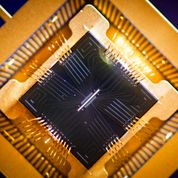The future of quantum computing: do the ions have it?
 Recently Science Magazine invited Joint Quantum Institute fellow Chris Monroe and Duke Professor Jungsang Kim to write about a promising approach to quantum computing: ion trap technology. Monroe and Kim write that trapped atomic ions can serve as quantum memories, communication network nodes and gate hosts in quantum computers and simulators. Their article is highlighted on the cover of the March 8, 2013 issue of Science, which is dedicated to quantum information.
Recently Science Magazine invited Joint Quantum Institute fellow Chris Monroe and Duke Professor Jungsang Kim to write about a promising approach to quantum computing: ion trap technology. Monroe and Kim write that trapped atomic ions can serve as quantum memories, communication network nodes and gate hosts in quantum computers and simulators. Their article is highlighted on the cover of the March 8, 2013 issue of Science, which is dedicated to quantum information.
At the heart of quantum computers are qubits, systems maintained in two or more quantum states simultaneously. In ion trap processing, the qubits are manifested in the internal energy levels of the trapped ions, and are manipulated through laser and microwave radiation. These technologies are a key factor in the success of quantum computing: scientists can set the frequency of the radiation to match that of the ion’s energy level spacings with extreme precision. The qubits have a long coherence time—meaning they can be placed in quantum states and remain that way long enough to perform calculations. Using this technique the qubit’s states are less sensitive to ambient disturbances like magnetic fields.
On the magazine’s cover is a photograph of a surface trap fabricated by Sandia National Labs and used to trap ions at JQI and Duke, among other laboratories. Learn more at the Joint Quantum Institute website.
"Scaling the Ion Trap Quantum Processor," C. Monroe and J. Kim, Science, March 8, 2013
Photo courtesy of the Joint Quantum Institute.


